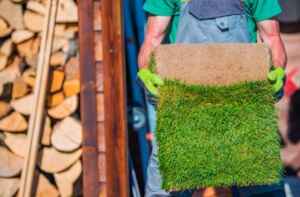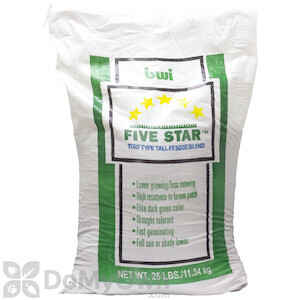Common Fescue Grass Problems in Winter
Fescue is a good choice for homeowners who want a low-maintenance, drought-tolerant lawn. It is also well suited for use on golf courses and other sports fields.
So, what are the most common winter problems for fescue grass? There are five common winter problems for fescue grass:
- Low nitrogen levels
- Thatch build-up
- Moss growth
- Winterkill
- Grub infestation.
During my research on fescue grass, there are many ways to prepare your fescue grass for the winter months.
 What is Fescue Grass?
What is Fescue Grass?
Fescue grass, also known as creeping red fescue or hard fescue, is a perennial low-growing turfgrass that produces excellent qualities for home lawns and sports fields. It is an extremely drought-tolerant grass and can tolerate shade and other adverse conditions. Fescue grasses are also commonly used in erosion control plantings.
The most widely used cultivars (cultivated varieties) of creeping red fescue are ‘Red Fescue‘ and ‘Elite’. They are suggested for use in southern areas, in combination with bluegrass or other fine-leaved grasses.
They can also be mixed with Kentucky bluegrass, but the resulting lawn will be less drought tolerant. Tall fescue (Festuca arundinacea) can also be used as turfgrass, but it is not as shade tolerant as creeping red fescue.
For fescue grass, it can survive this harsh climate of the Pacific Northwest because of one reason – its adaptability. Fescue grass contains endophytes which are symbiotic fungi that allow the plant to adapt to both extreme heat and cold. This makes it perfect for the Pacific Northwest because it can survive both summer heat and winter cold.
Endophytes are most commonly found in fescue, but not all varieties of grass have endophytes.
Creeping red fescue grows best in full sun to partial shade and in well-drained soils. It is a cool-season grass that goes dormant in the hot summer months. Fescue should be mowed at a height of 2-3 inches.
1. Low Nitrogen Levels
During winter, grasses go into a dormant state and don’t need as much nitrogen as they do during other times of the year. However, if your fescue lawn is lacking nitrogen, it will be less likely to green up in the spring.
To remedy this, give your lawn a slow-release nitrogen supplement during the early spring. One of the most common problems in winter is brown patches. This happens when the grass blades die and turn brown, often due to cold weather or drought.
2. Thatch Build-Up
During winter, some grasses go into a state of dormancy that turns their roots down and makes them grow horizontally along the surface of the ground instead of vertically.
This creates an organic layer called “thatch” that can suffocate your lawn if it’s left unchecked. To keep thatch under control, rake your lawn regularly during the winter months.
Reduce thatch build-up to help prevent other winter problems like brown patches and winter kill. You should also aerate your lawn in the fall to help with this. Thatch is a layer of dead grass that can build up over time, and it can often lead to problems like brown patches and winter kills.
3. Moss Growth
Moss is a common problem for fescue grass in the winter, especially if your lawn is shady or wet. To get rid of moss, start by aerating your lawn to improve drainage. Then, apply a moss killer to the affected areas.
Another common problem in winter is snow mold. This happens when the grass is covered in snow for an extended period, which can cause the blades to die and turn black. Root rot is a problem that can occur in winter when the soil gets too wet or there is poor drainage.
4. Winterkill
If you live in a cold climate, you may experience winterkill, which is when the crowns of the grass plants die due to extremely cold temperatures. Winterkill is most common in fescue lawns that are heavily infested with weeds or that have a low level of nitrogen.
To prevent winterkill, make sure your lawn is healthy and well-maintained, and avoid over-fertilizing it in the fall. Winter kill is when the cold weather causes the grass to die and turn brown. This is most common in areas that experience a lot of freezing temperatures.
5. Grub Infestation
Grubs are a common pest that can infest fescue lawns in the winter. They feed on the grassroots, which can kill the plants. A grub is a worm-like larva that is larger than most other larvae found in lawns or ornamental turfgrass. Grubs feed on the roots of grasses, causing them to brown and die. Most grubs in turfgrass are the larvae of Japanese beetles, European chafers, or May beetles.
These beetles lay their eggs in late summer and early fall. The eggs hatch into larvae that feed on the roots of grasses throughout the winter. The larvae are much easier to identify when they are full-grown in late spring and early summer. To get rid of grubs, apply a grub killer to your lawn in the early spring.

Preparation For Winter
Now that the colder months are upon us, it’s time to start preparing your fescue grass for winter. Fescue is a hardy grass that can handle cold weather conditions quite well, but there are a few things you can do to help make sure your lawn stays healthy all winter long.
One of the most important things you can do is to make sure your fescue is properly fertilized. Fescue needs a steady diet of nitrogen throughout the fall to stay healthy and withstand the cold winter weather. You can either fertilize your lawn yourself or hire a professional to do it for you.
Another thing you can do to prepare your fescue for winter is to overseed it with hardy grass-like rye. Rye will help to keep your lawn healthy and green all winter long, even if the weather turns cold and snowy.
If you take the time to properly prepare your fescue grass for winter, you can rest assured that your lawn will stay healthy and look good all season long. So don’t wait any longer, get started today! As the weather outside gets colder, you may start to notice some changes in your fescue grass.
Maintaining Fescue Grass
Maintaining your fescue lawn is easy if you follow a few simple steps. First, mow your lawn at the recommended height for your type of fescue grass. Fescue grows best when it is mowed at 2 to 3 inches high.
Second, fertilize your lawn twice a year, in the spring and fall to help your lawn stay healthy. And finally, water your lawn regularly (keep hydrated), especially during the summer months.
Fescue grass needs 1-2 inches of water per week, depending on the soil type. If you are not watering your lawn enough, it will turn brown. By following these tips, you can keep your fescue lawn looking healthy and green all year long.
Fescue grass is a type of cool-season turfgrass that is popular in the United States. It is used for lawns, sports fields, and golf courses. Fescue can be planted in spring or fall and will remain green throughout the winter months.
 When to Plant Fescue Grass
When to Plant Fescue Grass
Fescue can be planted in spring or fall and will remain green throughout the winter months. To take care of fescue grass in winter, make sure you are mowing your lawn at the right height, keep it hydrated by watering every week or so, and apply a winter fertilizer.
If you have poor drainage, improve it by adding a French drain or grading the soil so water drains away from your yard. Improve your soil’s fertility and pH levels to make sure your grass stays healthy all year long.
Apply lime if your soil is acidic, and add fertilizer if it’s not fertile enough. Water your lawn regularly, especially during times when it’s been colder for an extended period. This will help prevent brown patches and other winter problems.
Fescue should be mowed at least every 3 weeks. If it is mowed too infrequently, the grass will become tall and start to shade its leaves, causing them to turn brown at the tips. Solution: Mow your fescue lawn often enough so that you cut off no more than 1/3 of the leaf blade per mowing.
Mulching your fescue will help to keep the soil moist and will prevent weeds from growing. It will also help to keep the grass blades sharp. Solution: Mulch your fescue lawn using a mulching mower or by mulching leaves over the winter.
Warnings Using Fescue Grass
Fescue is not recommended for use in high-traffic areas.
Several pests and diseases can affect fescue grass. The most common pest is the sod webworm. Diseases that can occur include brown patches, red thread, dollar spots, and necrotic ring spots. There are several fungicides available to treat these diseases.
Fescue is a versatile grass that can be used for home lawns, sports fields, and erosion control. It is drought tolerant and shade tolerant, making it an excellent choice for many different applications. Fescue is susceptible to some pests and diseases, so be sure to consult with your local professional before choosing this grass for a new lawn.


